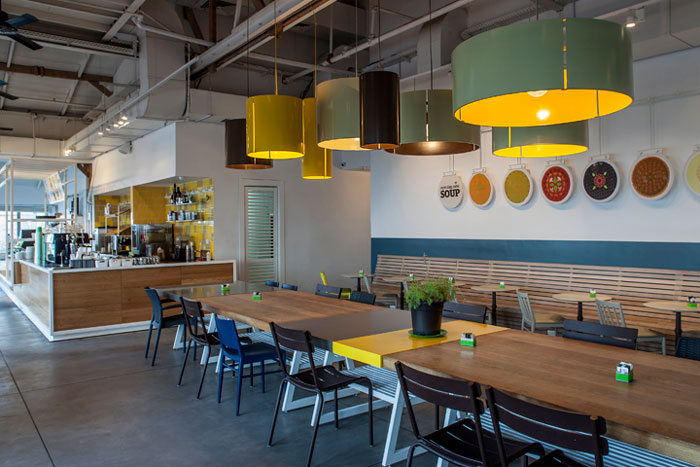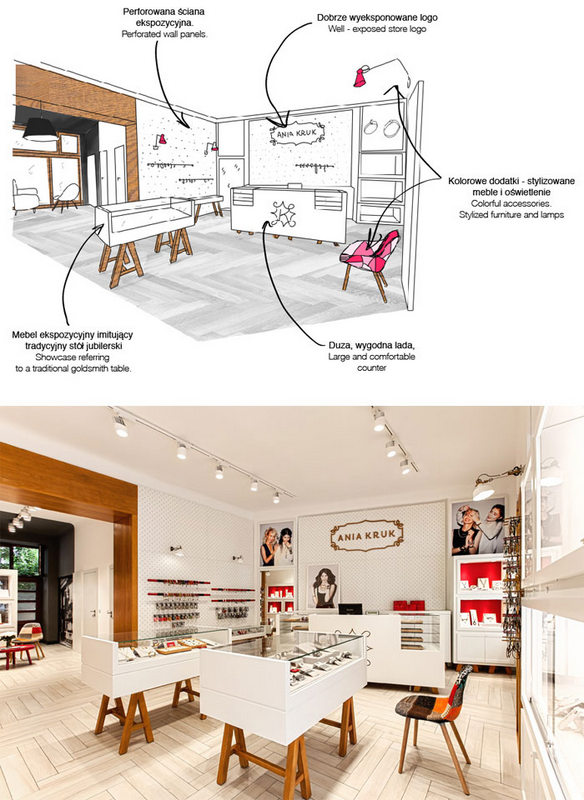
Ronen Levin design studio must have followed the typical interior design process to achieve this outstanding and beautifully detailed project for LovEat coffee shop.
Unless you’ve worked with a professional interior designer before, you may not realize how much work is actually invested into a successful business renovation or tenant improvement project. It’s not uncommon for business owners to seek out the help of an interior designer only to receive a fee proposal that, on first glance, may seem higher than originally anticipated.
In our experience, once that potential client reads through the scope of work, it becomes clear that there are many, many details for the consultant to address including meetings, phone calls, drawings, revised drawings, product sourcing, budgeting…you get the picture. In this second part of our series on the interior design process, we’re going to give you more information about the design development and contract documents phases of an interior design project.

Here’s a look at the design progression for Ania Kruk Jewelry Boutique by Mode:lina from design development to the final product. These sketches were a necessary part of the interior design process and that time spent was definitely worthwhile.
Ok, so we’ve already discussed the planning phases in our recent blog post, but to recap, in the first stages of the project we have investigated project goals and requirements and we’ve developed a functional space plan. Now, we can move on and get into the details of how the space plan will translate in the built form and how we communicate this to a General Contractor. These phases are called Design Development and Contract Documents.
Design Development
To be concise, design development, as it relates to interior design, is how we transform our vision for the space into a unique design plan. In reality, however, the design development stage is everything but concise as it involves a myriad of activities including:
- Devising a solid design concept or source of inspiration;
- Generating 3D models and sketches of key ideas and specialty components;
- Researching, presenting, refining, and determining finishes, fixtures, and furniture;
- Formulating details for millwork and custom features;
- Refining the design to reflect budget figures;
- Communicating with the client and other consultants via meetings, minutes, email and phone;
- Referring to local regulations and building codes for compliance;
- Reviewing preliminary consultant drawings; and
- Implementing various preliminary 2D plans including ceiling plans, finish plans, elevations and more.

Here’s a project, Pixar by Evoke International Design, with a strong design concept. The designers must have had fun meshing characters from Pixar movies, with the name “Pixar”. We approve and obviously, so did the client.
For this phase to be successful we need a strong starting point or vision. We take inspiration from the company’s brand message, logos & imagery, history, and future goals to devise a design story that directs the progression of the design. For example, the concept behind our Grouse River project was based upon the geographical layers found in nature and translating this natural beauty into modern forms, finishes, and fixtures within the space. Any time we were faced with a decision we would always refer back to this starting point to ensure we were staying on track.
As mentioned, at Hatch we work on 3D models. For us, this is an inherent part of the process as it helps us find the details that need to be refined, and it is a valuable communication tool so our clients can see what goes on in our crazy designer brains. If photos are worth 1000 words, 3D models must be worth a billion.
Design development sounds like a lot of work; that’s because it is. We find it accounts for about 30-40% of the project. That’s ok with us though, because it’s the fun part!

Another example, except this time showing the conceptual design for the firearms area at our Grouse River project, and then another of the final product. Our client can attest that the time we invested in properly detailing this area via the sequential interior design process, was valuable to his project.
Contract Documents
So, by now our clients and our design team are feeling pretty excited about things. We have a killer design plan and it’s full steam ahead to get this thing built. Whoa, hold your horses! We still have to put together the drawing set so that building permits can be acquired, pricing determined, and a General Contractor obtained. In this crucial phase we:
- Integrate a package that consists of drawings (demolition plans, partition plans, reflected ceiling plans, basic electrical and communication plans, finish plans, furniture plans, elevations, details, door schedules), specifications, code studies, and an instruction to bidders document;
- Coordinate with project consultants via meetings, emails, and drawing reviews to include engineered drawings within the package;
- Communicate with the client to facilitate their understanding and approval of the contract document package;
- Prepare materials required to aid the client in their application for a building permit.

You know that saying, “it’s all in the detail”? Well, it is. Your professional Interior Designer develops those details throughout a formulated interior design process. This component of the platte tables was conjured by Alice Tacheny.
Contract Documents is the phase of the project we try to do as quickly as possible (meaning, sigh, you’ll typically see us hard at work when you’ve turned off your TV and jumped into bed). There’s still a respectable amount of work to complete, but we want to see the project move into construction just as much as our clients (hence pulling off some long CAD sessions)!
Sounds like we’re done? Well…actually…no. Remember, you still need a General Contractor, and of course, firm pricing on the project, oh and don’t forget, our help to ensure the project is built as intended. But, this will have to wait for our next blog entry; check back soon and we’ll fill you in on these final stages.
» Excited to redesign your commercial interior? Contact Hatch Interior Design located in Kelowna, British Columbia – Because Good Design is Good Business™.